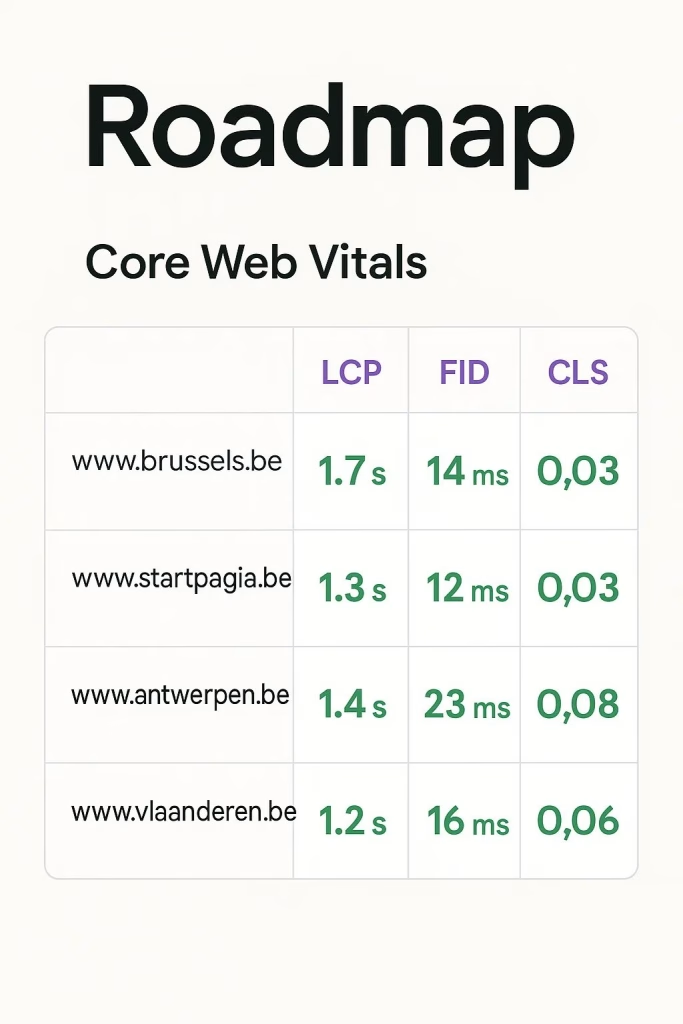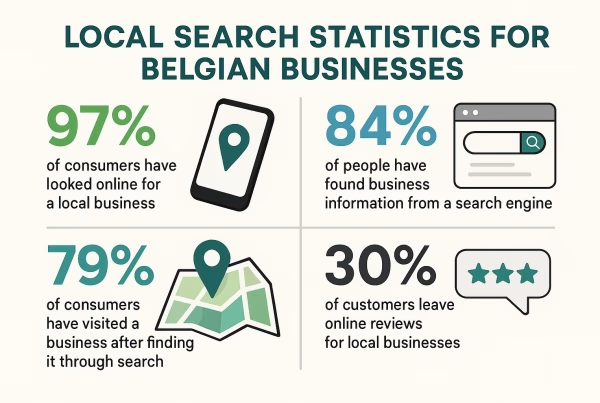Introduction
Last month, I was helping a Brussels-based e-commerce client whose website was hemorrhaging customers faster than they could acquire them. Their beautiful product pages loaded like molasses, and bounce rates were through the roof. Sound familiar? If you’re running a Belgian website that’s struggling with performance, you’re not alone—and more importantly, you’re not stuck with it.
Belgium‘s unique digital landscape presents specific challenges for website optimization. Between the multilingual requirements (Dutch, French, and German), GDPR compliance complexities, and the expectation for lightning-fast performance across different regions, Belgian websites need a tailored approach to Core Web Vitals optimization.
What Are Core Web Vitals and Why Belgian Websites Should Care
Core Web Vitals represent Google’s attempt to quantify user experience through three specific metrics: Largest Contentful Paint (LCP), First Input Delay (FID), and Cumulative Layout Shift (CLS). Think of them as your website’s vital signs—they tell you whether your site is healthy enough to keep visitors engaged.
For Belgian businesses, these metrics carry extra weight. With 53% of mobile users abandoning sites that take longer than 3 seconds to load, poor Core Web Vitals directly impact your bottom line. Belgian consumers, particularly in urban areas like Antwerp and Ghent, expect seamless digital experiences that match their high-speed internet infrastructure.
The Three Pillars of Core Web Vitals Performance
Largest Contentful Paint (LCP) measures loading performance. Your LCP should occur within 2.5 seconds of when the page first starts loading. For Belgian websites serving multiple languages, this becomes tricky when you’re loading different font sets for Dutch, French, and German content.
First Input Delay (FID) quantifies interactivity. Pages should have an FID of 100 milliseconds or less. I’ve noticed Belgian websites often struggle here due to heavy cookie consent banners required by GDPR—they’re necessary, but they can bog down interaction speed if not optimized properly.
Cumulative Layout Shift (CLS) measures visual stability. Your CLS score should be 0.1 or lower. Belgian retail websites frequently stumble with this metric because of dynamic pricing displays that adjust based on VAT requirements for different EU regions.
[Image placeholder: Screenshot showing Core Web Vitals scores dashboard with Belgian website examples] Alt text: Core Web Vitals dashboard displaying LCP, FID, and CLS scores for multiple Belgian websites, with green, yellow, and red performance indicators
Common Core Web Vitals Issues Plaguing Belgian Websites

After auditing dozens of Belgian websites, certain patterns emerge consistently. The most prevalent issue? Oversized hero images that look stunning on desktop but murder mobile loading times. I remember working with a Flemish tourism website that had gorgeous 4MB hero images of Bruges canals—beautiful, but absolutely devastating for LCP scores.
Image Optimization Challenges for Multi-Language Sites
Belgian websites face unique image optimization hurdles. When you’re serving the same visual content across Dutch, French, and German pages, you need smart strategies for handling text overlays and culturally relevant imagery. Many sites I’ve encountered serve different image variants for each language, tripling their image payload unnecessarily.
The solution involves implementing responsive images with proper srcset attributes and WebP format adoption. Modern browsers support WebP, which can reduce image file sizes by 25-35% compared to JPEG without quality loss. For Belgian sites targeting older demographics who might use legacy browsers, maintaining JPEG fallbacks remains crucial.
JavaScript Bundle Bloat from GDPR Compliance
Cookie consent management platforms can add significant JavaScript overhead. I’ve seen Belgian websites with cookie banners that load 200KB+ of JavaScript before users can interact with the main content. This directly impacts FID scores and creates a frustrating user experience.
The key is implementing lazy-loaded consent management that doesn’t block critical rendering paths. Consider using lightweight, locally-hosted cookie solutions rather than third-party services that require additional DNS lookups and script parsing.
Strategic Implementation Plan for Belgian Website Optimization
Phase 1: Audit and Baseline Establishment (Week 1-2)
Start with comprehensive performance auditing using multiple tools. Google PageSpeed Insights provides Core Web Vitals data, but supplement it with WebPageTest for detailed waterfall analysis and real-user monitoring tools like Chrome User Experience Report.
For Belgian websites, test from multiple geographic locations. Performance from Brussels might differ significantly from Liège due to CDN distribution and server proximity. Document baseline metrics for each major page template: homepage, product pages, blog posts, and contact forms.
Create a prioritized list of issues based on business impact. Homepage LCP problems affect more users than blog post CLS issues, so tackle high-traffic pages first.
Phase 2: Critical Resource Optimization (Week 3-4)
Focus on eliminating render-blocking resources that delay LCP. This means optimizing CSS delivery by inlining critical styles and deferring non-essential stylesheets. For Belgian multilingual sites, this becomes complex because different language pages might have varying critical CSS requirements.
Implement resource hints strategically. Use dns-prefetch for external domains (particularly important for Belgian sites using EU-based CDNs), preconnect for critical third-party resources, and preload for essential fonts and images.
Font optimization deserves special attention for Belgian websites. Loading separate font families for different languages can create performance bottlenecks. Consider using system fonts for body text and reserving custom fonts for headings only.
Phase 3: Advanced Performance Tuning (Week 5-6)
This phase involves sophisticated optimization techniques that require technical expertise. Implement proper caching strategies using browser caching, CDN configuration, and server-side caching solutions.
For Belgian e-commerce sites handling multiple currencies and VAT calculations, edge computing can significantly improve performance. Process dynamic pricing calculations at CDN edge locations rather than origin servers to reduce Time to First Byte (TTFB).
Consider implementing Service Workers for repeat visitors. Belgian websites often have high return visitor rates, making aggressive caching strategies particularly effective for improving perceived performance on subsequent visits.
Measuring Success and Ongoing Optimization
Performance optimization isn’t a one-time project—it’s an ongoing commitment. Establish monitoring systems that alert you when Core Web Vitals degrade. For Belgian websites serving business customers during specific hours, consider time-of-day performance analysis to identify peak load issues.
Set up A/B testing for major optimization changes. I learned this lesson the hard way when implementing lazy loading on a Belgian B2B website and accidentally breaking lead capture forms for users with JavaScript disabled (yes, they still exist, especially in enterprise environments).
Real-User Monitoring for Belgian Market Insights
Implement Real User Monitoring (RUM) to understand how actual Belgian users experience your website. Synthetic testing tools are valuable, but they can’t replicate the diverse device and network conditions your users face.
Pay particular attention to mobile performance data. Belgian mobile internet speeds vary significantly between urban and rural areas. What performs well in Brussels might struggle in smaller Walloon villages with limited 4G coverage.
Track Core Web Vitals alongside business metrics. Improved LCP scores mean nothing if they don’t correlate with increased conversions or reduced bounce rates. Establish clear connections between technical improvements and business outcomes to justify ongoing optimization investments.
Conclusion: Building Faster Belgian Websites That Convert
The journey to exceptional Core Web Vitals performance requires patience, technical expertise, and continuous monitoring. Belgian websites face unique challenges, but with systematic implementation and ongoing attention, you can create digital experiences that not only satisfy Google’s algorithms but delight your users.
Remember, performance optimization is never truly finished. Web technologies evolve, user expectations rise, and Google’s algorithms adapt. Stay curious, keep testing, and never assume your current performance levels are “good enough.” Your Belgian customers—and your search rankings—will thank you for the effort.
Whether you’re running a small Brussels boutique or a major Flemish enterprise, investing in Core Web Vitals optimization isn’t just about pleasing search engines—it’s about respecting your users’ time and creating experiences worthy of their attention. Start with the basics, measure everything, and iterate relentlessly. Your bottom line will reflect the effort you put into making your website blazingly fast.
Related Articles to Explore
Pillar Article:
- Complete Guide to Website Performance Optimization for Belgian Businesses
Supporting Content:
JavaScript Optimization for Better First Input Delay Scores
GDPR-Compliant Cookie Management Without Killing Website Speed
Multilingual Website Performance: Optimizing Dutch, French, and German Content
Mobile Performance Optimization for Belgian E-commerce Sites
Server-Side Performance Tuning for Belgian Hosting Environments
Core Web Vitals Monitoring and Alerting Systems
Image Optimization Techniques for High-Performance Belgian Websites






